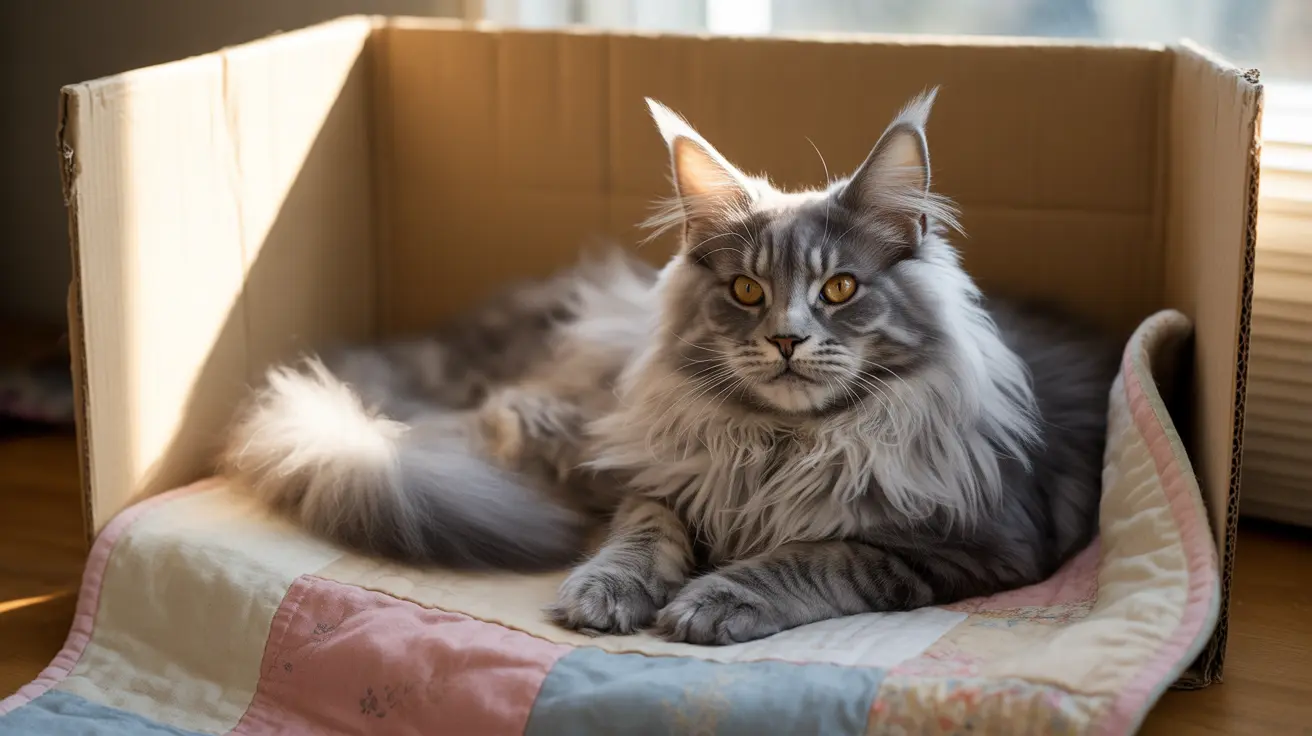10 Favorite Cozy Resting Spots for Cats: Creating the Perfect Sleep Haven
Understanding where your feline companion chooses to rest can reveal fascinating insights into their instincts, preferences, and emotional bonds with you. Cats spend an impressive 12-16 hours each day sleeping, making their choice of cozy resting spots for cats a crucial aspect of their wellbeing. These natural-born nappers don't just randomly plop down anywhere—they carefully select locations that meet their deep-seated needs for security, warmth, elevation, and proximity to their favorite humans.
Whether your cat curls up in a cardboard box, claims the top of your wardrobe, or insists on sleeping directly on your chest, each choice reflects their unique personality and survival instincts. By understanding these preferences and learning how to enhance these spaces, you can create an environment that not only keeps your cat happy and comfortable but also strengthens the special bond you share. Let's explore the top 10 favorite resting spots that cats gravitate toward and discover practical ways to make these areas even more appealing for your feline friend.
Elevated Perches: Why Cats Love Heights
Cats instinctively seek elevated sleeping areas because height provides safety and a commanding view of their territory. These elevated cozy resting spots for cats satisfy their natural need to monitor their environment while remaining protected from potential ground-level threats. Popular elevated locations include the tops of kitchen cupboards, empty shelves, backs of sofas, and furniture surfaces that offer both security and visibility.
The psychology behind this preference stems from their wild ancestry, where sleeping in trees or on rocky outcrops meant survival. When your cat chooses the top of your wardrobe or bookshelf, they're following millions of years of evolutionary programming that equates height with safety.
Enhancing Elevated Spots
To make elevated areas more comfortable, ensure they're easily accessible, especially for older or less mobile cats. Add soft, fleecy bedding to hard surfaces, and consider installing cat-friendly shelving or wall-mounted climbing systems. Make sure these spots aren't too close to heat sources but are away from draughty areas to maintain comfortable temperatures.
Enclosed Hideaways: The Security of Small Spaces
Cardboard boxes, wardrobes, closets, and other enclosed spaces rank among the most beloved cozy resting spots for cats. These hideaways satisfy their instinctual need for security and protection, providing a sense of being hidden from potential predators while still allowing quick escape routes. Beds with tall sides or covered areas offer similar psychological benefits, helping cats feel safe and undisturbed during their long sleep sessions.
The appeal of enclosed spaces also relates to temperature regulation and scent concentration. Small, confined areas trap the cat's body heat more effectively and concentrate familiar scents, creating a comforting microenvironment that promotes deeper, more restful sleep.
Creating Perfect Hideaways
Provide various hiding options throughout your home by leaving empty cardboard boxes in quiet corners, offering covered cat beds, or creating cozy caves using blankets and furniture. Ensure these spaces have clear escape routes and aren't located in high-traffic areas where your cat might feel trapped or stressed.
Warm Zones: Heat-Seeking Comfort
Cats are natural heat-seekers, often gravitating toward warm spots like sunny windowsills, areas near heaters, or heated beds. Their preference for warmth stems from their desert-dwelling ancestors and helps them conserve energy by maintaining optimal body temperature without expending calories on thermoregulation.
Specialized heating-mounted beds and heated cat mats can transform ordinary spots into irresistible cozy resting spots for cats. However, it's crucial to position these away from direct heat sources to prevent overheating while ensuring they're not in draughty areas that could create uncomfortable temperature fluctuations.
Optimizing Warm Spots
Create warm, comfortable areas by placing beds near (but not directly against) heating vents, providing heated cat beds with adjustable temperature settings, or simply ensuring sunny windowsills have comfortable cushions. During colder months, consider moving some of your cat's favorite beds to naturally warmer areas of your home.
Human Furniture: Sharing Your Space
Your bed, sofa, and favorite armchair often become prime cozy resting spots for cats, and this preference goes far beyond simple comfort. When cats choose to sleep on human furniture, they're seeking proximity to their favorite people while enjoying the softness and familiar scents that these items provide.
Cats sleeping on beds often choose specific locations—near the head for the strongest human scent and trust, on the chest for warmth and the calming rhythm of breathing and heartbeat, or at the feet for a balance of closeness and independence with an easy escape route. Each position reflects different aspects of your cat's personality and their relationship with you.
Making Shared Spaces Work
If you welcome your cat on furniture, provide washable throws or designated blankets to protect upholstery while maintaining their access to these beloved spots. For owners who prefer cats stay off certain furniture, consistency in rules is crucial—provide equally appealing alternative cozy resting spots for cats nearby to redirect their attention.
Scent-Rich Areas: Following Familiar Smells
Laundry baskets, particularly those containing worn clothes, rank high among favorite cozy resting spots for cats because they concentrate the owner's scent. Cats rely heavily on scent to understand their environment and feel secure, making these scent-rich areas incredibly appealing for rest and relaxation.
This behavior demonstrates the deep emotional bond between cats and their owners. When your cat chooses to sleep in your laundry basket or on your recently worn clothing, they're seeking comfort in your familiar scent, even when you're not physically present.
Leveraging Scent Comfort
When washing bedding, avoid cleaning all cat beds simultaneously to maintain familiar scents that help your cat feel secure. Consider placing a worn t-shirt or pillowcase in your cat's bed to provide comforting scent markers that enhance their feeling of safety and belonging.
Chair Sanctuaries: Safe Spots Near Humans
Chairs, especially those tucked under dining tables or positioned in quiet corners, offer ideal cozy resting spots for cats. These locations provide the perfect combination of security, proximity to human activity, and easy escape routes. The enclosed feeling of being under a table satisfies cats' desire for covered spaces while keeping them close to family interactions.
Dining room chairs are particularly appealing because they offer front-row seats to household activity without being directly in the path of foot traffic, allowing cats to observe and participate in family life while maintaining their sense of security.
Optimizing Chair Comfort
Add cushions or soft blankets to hard chair seats to increase comfort, and ensure these areas remain relatively quiet and undisturbed during your cat's preferred sleeping hours. Consider designating specific chairs as "cat chairs" to provide consistent, reliable resting spots.
Seasonal Cool Spots: Summer Comfort Zones
During warmer months, cats shift their preference to cooler cozy resting spots for cats, seeking out tiled floors, bathroom sinks, or patches of soil if they have outdoor access. This temperature-seeking behavior demonstrates cats' remarkable ability to self-regulate their body temperature by choosing appropriate resting locations throughout the year.
Cool surfaces like tile, stone, or even porcelain sinks provide relief from heat while still offering some of the security and comfort cats crave. These spots often become temporary favorites during hot weather, with cats abandoning their usual warm hideaways for these cooling alternatives.
Seasonal Adaptations
Provide cooling options during summer months by ensuring access to tiled areas, offering elevated beds that allow air circulation, or providing cooling mats designed specifically for pets. Adjust the location and type of bedding seasonally to match your cat's changing temperature preferences.
Window Perches: The Ultimate Observation Posts
Windowsills and window-mounted cat beds combine multiple appealing elements: elevation, warmth from sunlight, and endless entertainment from outdoor activity. These spots rank among the most coveted cozy resting spots for cats because they satisfy both comfort needs and natural curiosity about the outside world.
The combination of natural light, warmth, and mental stimulation from watching birds, people, and other outdoor activities makes window areas irresistible to most cats. These locations also provide the security of being indoors while maintaining visual connection to the larger territory beyond.
Maximizing Window Appeal
Install sturdy window perches or provide comfortable cushions on wide windowsills to create dedicated viewing and resting areas. Ensure these spots receive adequate sunlight during your cat's preferred napping times, and consider adding bird feeders outside windows to enhance the entertainment value.
Cat Trees and Dedicated Furniture
Purpose-built cat trees, towers, and dedicated cat furniture offer some of the best cozy resting spots for cats because they're designed specifically with feline preferences in mind. These structures typically combine multiple appealing elements: elevation, hiding spots, scratching surfaces, and multiple levels that allow cats to choose their preferred height and degree of enclosure.
The strategic placement of cat trees near windows or in areas where family activity occurs allows cats to participate in household life while having dedicated spaces that belong entirely to them. This territorial aspect is crucial for cats' psychological wellbeing.
Selecting and Positioning Cat Trees
Choose cat trees with various types of resting areas—open platforms for cats who like to stretch out, enclosed caves for security-seekers, and hammocks for cats who enjoy gentle swaying. Position these structures near windows or in areas where your cat can observe household activity while having easy access to other necessary resources.
Under-Bed Hideouts: Ultimate Privacy Zones
The space under beds represents the perfect combination of security, privacy, and proximity to their favorite humans, making these areas prime cozy resting spots for cats. The low, enclosed nature of under-bed spaces appeals to cats' desire for den-like environments while keeping them close to their owners' scent and presence.
This location also provides an excellent escape route during stressful situations, allowing cats to retreat to safety while remaining within their established territory. Many cats alternate between sleeping on top of the bed with their owners and retreating underneath for more private rest periods.
Improving Under-Bed Access
Ensure easy access for cats of all ages and mobility levels by providing steps or ramps if needed. Keep the under-bed area clean and free of storage items that might make the space cramped or uncomfortable, and consider adding a soft mat or cushion to make hard floors more comfortable.
Health Benefits of Different Resting Spots
Different types of cozy resting spots for cats offer various health benefits that contribute to overall feline wellbeing. Elevated sleeping areas can reduce stress by providing security and territory control, while warm spots help maintain joint health, especially important for older cats with arthritis or mobility issues.
Enclosed spaces promote deeper, more restorative sleep by reducing anxiety and creating a sense of safety that allows cats to fully relax. The psychological benefits of having multiple resting options include reduced territorial stress in multi-cat households and improved mental stimulation from varied environments.
Supporting Senior Cats
Older or less mobile cats may need additional considerations when accessing their favorite spots. Provide ramps or steps to elevated areas, ensure beds have lower sides for easier entry and exit, and consider orthopedic bedding that supports aging joints and muscles.
Creating a DIY Cat Paradise
Building your own cat-friendly environment doesn't require expensive purchases—many of the best cozy resting spots for cats can be created using household items and simple modifications. Cardboard boxes with soft blankets, repurposed furniture arranged to create elevated pathways, and strategic placement of cushions can transform any home into a cat paradise.
Consider your individual cat's personality when designing their space: shy cats benefit from more enclosed, hidden areas, while confident cats might prefer open, elevated perches that offer commanding views of their territory.
Balancing Comfort and Stimulation
While providing comfortable resting areas is crucial, balance these cozy spots with stimulating play areas and interactive elements. Position scratching posts near favorite beds, as cats often stretch and scratch after waking, and ensure easy access to food, water, and litter boxes without compromising the peacefulness of sleeping areas.
Maintaining Hygiene Around Rest Areas
Keeping your cat's favorite cozy resting spots for cats clean and hygienic is essential for both feline and human health. Regular washing of bedding, vacuuming of furniture and elevated surfaces, and maintaining clean litter boxes away from sleeping areas all contribute to a healthy environment.
When cleaning, remember that cats rely heavily on scent for security and comfort. Avoid washing all bedding simultaneously, and introduce freshly cleaned items gradually to maintain some familiar scent markers that help your cat feel secure in their environment.
Frequently Asked Questions
- Why does my cat keep changing sleeping spots throughout the day?
Cats naturally switch between different sleeping locations to protect themselves from parasites and to follow optimal temperature and lighting conditions throughout the day. This behavior also satisfies their instinctual need for variety and security by not becoming predictable to potential threats.
- Should I provide multiple beds if I have just one cat?
Yes, even single cats benefit from having several bed options positioned around the house. This allows them to choose spots based on their current needs—whether they want warmth, elevation, privacy, or proximity to family activity. Having multiple options reduces stress and increases comfort.
- Is it okay to let my cat sleep on my bed?
Allowing cats to sleep on beds can promote emotional bonding and comfort, but consider potential health risks and sleep disruption. If you choose to share your bed, maintain consistency in your rules and ensure your cat has alternative comfortable options when needed.
- Why does my cat prefer to sleep in cardboard boxes over expensive cat beds?
Cardboard boxes provide the perfect combination of security, insulation, and familiar texture that appeals to cats' instinctual preferences. The enclosed walls offer protection while the corrugated material provides insulation and interesting textures. Simple boxes often meet cats' needs better than elaborate commercial beds.
- How can I encourage my cat to use their designated sleeping area instead of my furniture?
Make designated areas more appealing by ensuring they offer the same benefits your furniture provides—comfort, elevation, warmth, and proximity to family activity. Use familiar scents like worn clothing, maintain consistency in rules, and avoid forcing the change, which can create stress and behavioral issues.
- When should I be concerned about changes in my cat's sleeping habits?
Monitor for significant changes in sleeping location, duration, or positions, as these can indicate health or stress issues. If your cat suddenly avoids previously favorite spots, sleeps much more or less than usual, or shows signs of discomfort when resting, consult with your veterinarian for proper evaluation.
- How do I keep my cat's sleeping areas clean without disturbing their comfort?
Wash bedding in rotation rather than all at once to maintain familiar scents. Use washable throws on furniture, vacuum elevated surfaces regularly, and ensure sleeping areas are positioned away from litter boxes and feeding stations. Introduce freshly cleaned items gradually alongside familiar-scented options.
Conclusion
Understanding and accommodating your cat's preferences for cozy resting spots for cats is one of the most rewarding aspects of feline companionship. By recognizing that each chosen location reflects deep-seated instincts for security, warmth, elevation, and social bonding, you can create an environment that truly supports your cat's physical and emotional wellbeing. Whether your feline friend prefers the heights of a bookshelf, the security of a cardboard box, or the warmth of your lap, each choice tells a story about their personality and their trust in you.
Remember that the best approach combines respect for your cat's natural preferences with thoughtful enhancements that increase comfort and safety. By providing variety, maintaining cleanliness, and staying attuned to changes in sleeping patterns, you'll create a home where your cat can enjoy the restorative sleep they need while strengthening the special bond you share. The investment in understanding and improving these cozy resting spots pays dividends in the form of a happier, healthier, and more trusting feline companion.






